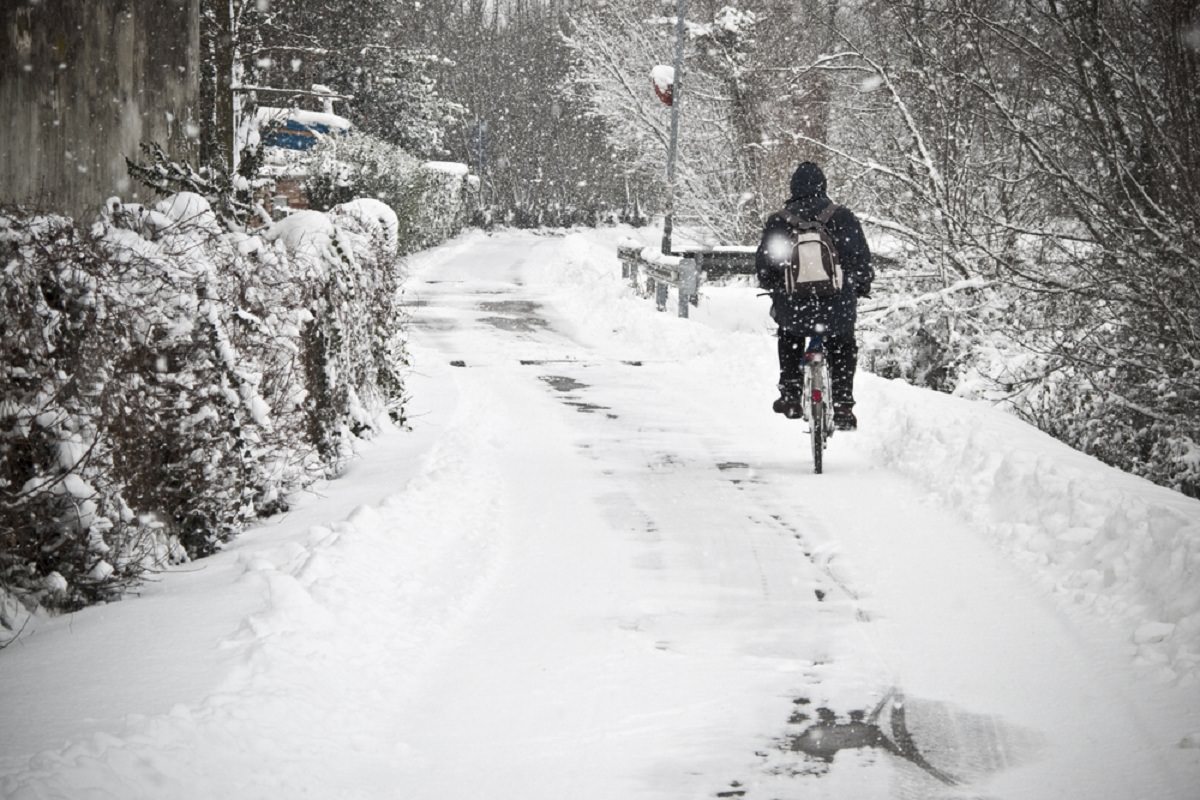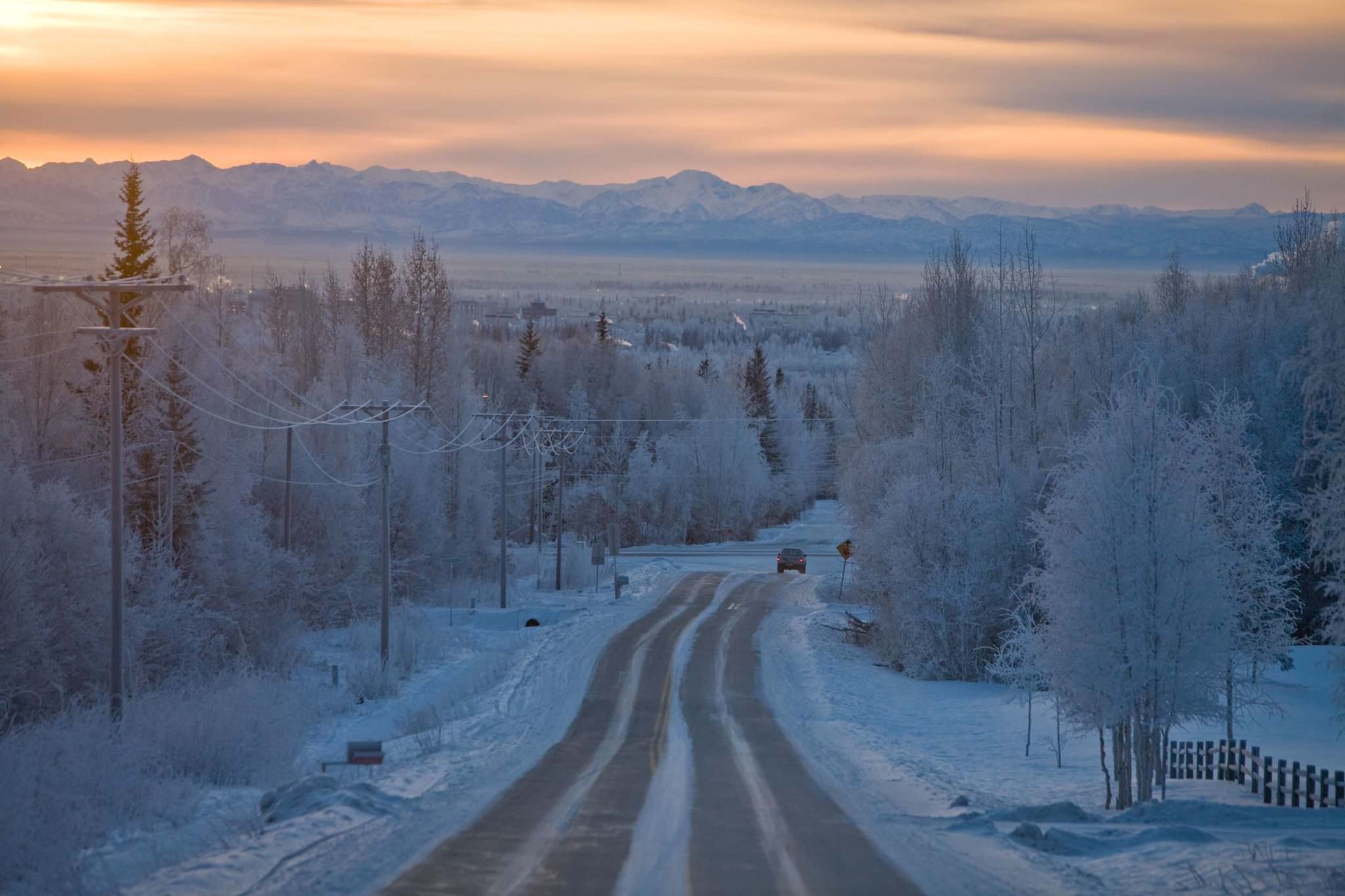What to wear in the winds of winter? How to keep from freezing? This is what keeps a lot of folks from icebiking, fear of the cold. But as we have stated elsewhere, fear of overheating is more warranted.
This is not to say that you can’t get cold out there. However, as long as you have the energy to work a little harder you can usually warm up by adding 2mph to your average speed. Usually. There are some days where it is just too cold out to be able to build up much heat, and then you have to be sure about your clothing.
As we stated on our dressing strategies page, the layering technique is not always that practical. You can’t always stop and adjust layers while cycling because the unique requirements of cycling restrict you from changing the under-layers, not the top layers, and this is a great deal of trouble unless you will be cycling for a long time.
For commuting trips, minor miscalculations of the weather are more easily handled by adjusting the workload to increase or decrease the heat you are generating. That being said, however, the main tenant of the layering principle, the use of multiple garments rather than a single heavier garment still is valid for winter cycling. For your icebiking, you want to use several different garments in different combinations to achieve the weather protection required for the day of the ride.
How to Layer Winter Cycling Jackets
Outer layers – cold wet
For cold wet environments (or times of year), one of the best outer layers you can get is a rain suit. Especially a Gore-Tex rain suit, and most especially one of the newer triple-layer Gore-Tex rain suits. While these may be ordered from Nashbar, Performance Bike, and Colorado Cyclist, I would recommend you march right down to the LBS and try a few on.
(I have a cyber-buddy in Italy who ordered a rain suit from Nashbar, only to have it arrive too small, and the postage back and forth was worth more than he paid for it.)
When trying on rain suits be sure to buy the pants too long. Way too long. Your knees will be bent on the bike and the pant legs will ride up.
The winter rain jacket should have “pit zips”, and a full front zipper. The typical commuter-special is for example Cannondale Tempest Jacket (with hood). This jacket has a liner to keep the cold outer surface off of your skin or jersey. Note the cuff closures. This jacket is so common it is almost a cliché for commuting in the rain. That’s because it works very well.
Avoid the Pull-Over style, they are generally a pain in the neck when you have a couple of layers below. Get the rain suit jacket too big too. This is no time to be worrying about being “aero”. You will want some room under the jacket to add layers. I will discuss these under layers below.
The passing reference to the pit zips should not be taken lightly. These handy little vents, if properly implemented and used can be the equivalent of shedding a layer, but you don’t have to stop to do it and you don’t have to find someplace to store the layer. It is one of the first things I look for in a cycling jacket.
Secondly look for a ventilated back, just under your shoulder blades. By slightly unzipping the front, a breeze will blow through, and this back vent and the pit zips and dump a lot of heat (and moisture) quickly. And just as quickly you can re-zip both the front and the pits. The colder it gets, the less you will need the back vent, but the pit zips are something you will not want to forego.
Some will warn you that at temperatures below freezing Gore-Tex can clog up with ice crystals from sweat that your undergarments wicked up. True enough. However, when this happens it is no worse than any other non-breathing wind-breaker or shell, and until that point, you’ve gained the advantage of a breathable top layer.
So don’t abandon your rain jacket just because it is too cold to rain, you can continue to use it until it’s just plain too cold. It’s usually time to switch jackets from a comfort point of view about the time the Gore-Tex is rendered ineffective by the cold temperatures. For me, this occurs at about 20 F.
On the other hand, you were sold this magic fabric with the hype that it DID “breathe” and would pass moisture even in the cold.
The truth is that moisture venting through the Gore-Tex in really cold weather gets as far as the outer layer and freezes, progressively plugging all of the highly vaunted pores. If you are passing enough heat through your outer layer to prevent this freezing, the jacket may continue to vent as advertised, but in that case, you are likely overheating under your other layers or suffering a heat loss you can ill afford.
The rain jacket can be worn down to about 20 to 10 (F) with appropriate layers underneath. It provides good wind protection and the Gore-Tex will vent the moisture wicked up by the under-layers to a degree. Much below this temperature and you will want something heavier or else a larger number of layers below it.
A somewhat different approach to cold-wet is the Buffalo Company product line. See our special review.
Outer layers – cold dry
In Cold Dry areas, or after the rains have passed, your hopes of finding cycling-specific gear suitable for the temperatures diminish. While some companies (such as Cannondale) are coming out with items supposedly designed for winter, I am not sure they tested them by icebiking in them.
Luckily there are still ski shops and outdoor shops carrying clothing for these climates. Some ski jackets have snow skirts that form a barrier around your waist to prevent breezes from swooshing up there as you pedal along. In really cold weather this may be quite welcome.
Remember that cyclists work up way more sweat than skiers, so don’t buy a jacket that is too heavy. The North Face makes an extra lightweight Windstopper Fleece jacket that is just right for many cyclists. It’s called the Sentinel Jacket (see separate write-up here).
It breaths very well, even when you are working hard. It has extra large pockets and is cut long enough that it does not ride up while you’re in the saddle. It does not have pit zips, but in the temperature range it’s designed for (below freezing) it works very well.
Things To Avoid When Layering For Winter Cycling
Avoid the “bomber” jacket-length garments. This rides up and exposes your lower back to all manner of breezes, and if you should auger in, snow will find its way up your back to your armpits. Many ski jackets are too short. Avoid open cuffs, you want either Velcro closures or elastic cuffs to keep the breezes at bay. Avoid long coats that make it difficult to pedal.
Columbia also makes a longer version of their popular Bugaboo line that is just long enough for really cold weather biking. In addition, there are many other brands of ski-oriented jackets and parkas that are light enough to bike in but warm enough for very cold weather. These jackets are far less breathable than the lighter cycling-specific jackets, but there is a limit to how much breathability you want when the outside temperature is 20 below.
Many of these are built with zip-out fleece liners so that the more-or-less rainproof upper can be used at warmer temperatures. It fits right into the multiple garment combinations method. This type of Jacket will take you down to -30(F) and perhaps lower with the right undergarments.
Normal winter jackets may also work. Big heavy hard-to-move-in ones will be hard to ride in. In this day and age, heavy does not always equate with warm. I’ve never liked down jackets for biking. You may disagree.
How To Layer Up-My Experience
I’ve tried riding in my ski jacket, but the hunched-over position blows wind down my neck, necessitating extra neckwear. I prefer my slightly oversized cycling jacket together with as many layers as necessary. The layers on top are:
- Polypro undershirt
- T-shirt
- Sweatshirt
- Polarfleece jacket (with pit zips!)
- Cycling jacket
This can take me to -25deg Celsius (about -15F). Below that I’d add another t-shirt or something. The cycling jacket has a long back but a short front – with a long ski jacket the front was always in the way of my legs, and with a bomber-style ski jacket, your back would be bare.
Summary – I use cycling clothing for the outside wind-proof layer because it’s *designed* for the position and wind profile of cycling.
John E. Abraham
Under Layers
Under the upper layer, you will need at least one other layer, depending on the temperature. If it is above 35(F) you might be able to get by with just a long-sleeved cycling jersey. The modern cycling jersey, made of newer fabrics that wick moisture away from the skin is often good lower layers regardless of temperature.
Alternatives are many of the garments made by outdoor companies using newer fabrics. Shown here are two garments from the very “UN-Cycling” sources of The North Face (polyester fleece middleweight – top) and Patagonia (Capilene lightweight -bottom).
These garments stay quite warm when damp and they also transport moisture away from the skin. The inside of your outer layer will have moisture condensed on it, but these shirts will be dry to the touch. Magic!
Depending on the temperature, you might wear just the middleweight under your outer layer, or both of them together. Combined with the Cannondale Rain Jacket these can take you down to maybe 10(F). After that, you might drop the inner layer and move to a heavier upper layer, such as the newer “Windblock” fleece.
When it is really cold out, say colder than -10(F) the polyester fleece type of fabric is a very good choice for under layers. Sometimes an “air-trap” layer (fabrics with a mesh or netting appearance) just above the wicking layer helps prevent heat loss. Don’t make the mistake of putting the air trap below the wicking layer.
If you can tolerate wool next to your skin it too may be a good choice. It is warm when wet, but it does not wick moisture away from the skin as well as modern fabrics. You will be much more comfortable with a Capilene or polypropylene skin layer below the wool.
Here is where I have to throw in the obligatory warning about cotton next to the skin. DON’T DO IT. Cotton isn’t even very pleasant if separated from the skin by another layer.
FAQs
Is it harder to cycle in winter?
Yes, it is harder to cycle in winter due to the freezing temperatures, icy roads, and less daylight.
What temperature is too cold for cycling?
Generally cycling below (0°C or 32°F) is considered too cold for cycling.
Is winter cycling safe?
Can I cycle in 0 degrees?
Recap
Occasionally I have been forced to wear a sweatshirt due to the unavailability of anything else, and I am amazed how muggy they can feel after just a short ride. Try a cotton sweatshirt on your next short ride. See how it feels, and then let me know if I was wrong.
Should you have any questions or require further clarification on the topic, please feel free to connect with our expert author John Andersen by leaving a comment below. We value your engagement and are here to assist you.











1 thought on “How to Layer Winter Cycling Jackets”
Avoid long coats that make it difficult to pedal. I really like it.